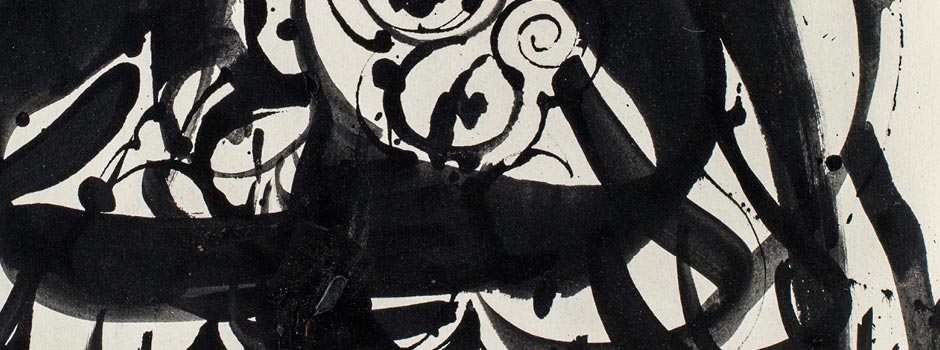
GROUP EXHIBITION AT THE GALLERY ISABELLE VAN DEN EYNDE (JAN 20 – MARCH 3) (Un)conscious - A Series of Small Serendipities
Feb 15, 2018 Exhibition

Gallery Isabelle van den Eynde is pleased to present (Un)conscious: A series of Small Serendipities, a group exhibition in which five artists Abdelkader Benchamma, Vikram Divecha, Mohammed Kazem, Ahmad Amin Nazar and Hassan Sharif apprehend the irreconcilable dichotomy of existence encompassing the separation between the spirit and the body, essence and appearance. Yet the artists allow themselves to evolve in a ‘third’ reality that challenges the common idea of mutual exclusiveness of chance and determinism.
Also a metaphysical space, these interstices allude to the most authentic form of life, the one of the ‘unconscious’ mind. Continuously seeping through reality, this unavoidable drive that inhabits us as a slid, a gap, a fold, a knot, or a swirl, constantly pulsates, comes and goes, opens and closes. The parenthesised prefix in the title of the exhibition in fact underlines the difficult negotiations between internal and external wanderings as well as the potentiality of chance as artistic modus operandi.
Kazem attempts to convert invisible ideas into shape and visualise otherwise transient phenomena and abstract notions. Known for his scratch paintings that represent sound, his newly realised works of graphite and ink lines follow a trajectory of chance that allows a subterranean light to emanate from the depths of the surface. Luminous orange, muted tones of lilac, pale blue and grey, and pinkish white hues emerge from a white background, presenting a light and airy approach to colour. They not only relate to nature, but also reflect invisible events through their transparency.
-No7_2017_Acrylic-and-ink-on-paper.jpg) Mohammed Kazem, Soundless (Fire) No.7, 2017, Acrylic and ink on paper, 59 x 41 cm / Courtesy of the artist and Gallery Isabelle van den Eynde
Mohammed Kazem, Soundless (Fire) No.7, 2017, Acrylic and ink on paper, 59 x 41 cm / Courtesy of the artist and Gallery Isabelle van den Eynde
Mohammed Kazem (born 1969, Dubai) lives and works in Dubai. He has developed an artistic practice that encompasses video, photography and performance to find new ways of apprehending his environment and experiences. The foundations of his work are informed by his training as a musician, and Kazem is deeply engaged with developing processes that can render transient phenomena, such as sound and light, in tangible terms. Often positioning himself within his work, Kazem responds to geographical location, materiality and the elements as a means to assert his subjectivity, particularly in relation to the rapid pace of modernisation in the Emirates since the country’s founding. Kazem presents Ways of Marking, curated by Murtaza Vali at New York’s Aicon Gallery from 17 January till 24 February.
A sense of disorientation and suspension hovers over Benchamma’s new works that investigate the archetypal image of a cave in an attempt to depict a transcendental world of ideas and forms. From drawings on paper to immersive mural installations, Benchamma has developed a rigorous grammar of the organic matter. Sense of time and space are lost in Cave (2017) drawings, where minuscule figures wander in mysterious passageway dominated by deep strata of minerals. The cave is a transformative space where a new world begins; it symbolises a search for the meaning of life. Is the exit of cave the projection of its own shadow that would mislead people to mistake appearance for reality? Or is it a gateway to another level of creation?
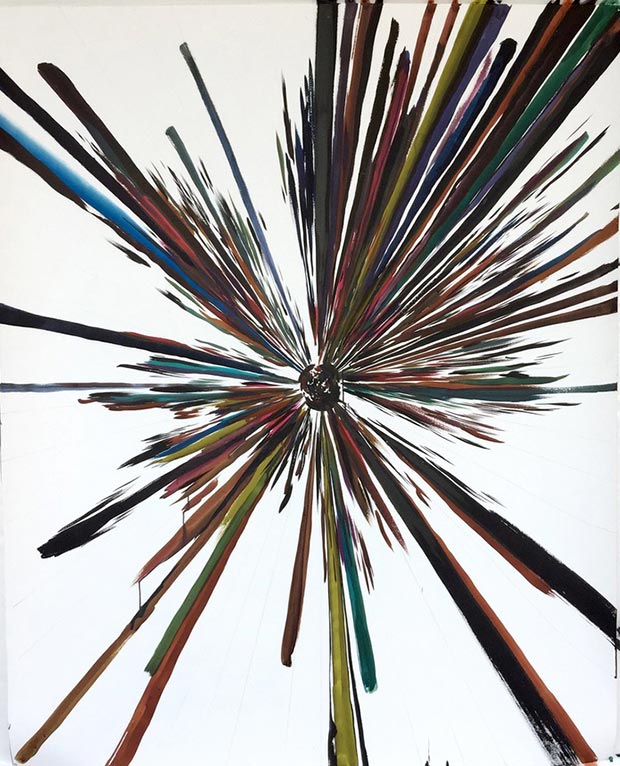 Abdelkader Benchamma, Untitled, 2017, Ink on paper, 160 x 150 cm / Courtesy of the artist and Gallery Isabelle van den Eynde
Abdelkader Benchamma, Untitled, 2017, Ink on paper, 160 x 150 cm / Courtesy of the artist and Gallery Isabelle van den Eynde
Abdelkader Benchamma (born 1975, Mazamet) lives and works between Paris and Montpellier, and studied Fine art at Ecole des Beaux-Arts, Paris. He imposes constraints upon his process to create delicately executed and dynamic drawings of states of matter. Events explode off the page and are animated by fusing graphic techniques from printing, engraving, landscape and scientific drawing. In his scenes he reveals the purity and intensity of lines to express powerful and ambiguous atmospheres, which probe notions of a stable reality. Benchamma will present a solo show, curated by Yasmina Reggad, at Cent-Quatre, Paris in March.
Sharif replaces the use of paintbrush to draw with rope, which is sometimes dipped into colourful acrylic paint or wrapped around fabric, electrical cable and copper wire. In doing so, his Objects become abstract paintings. Based on the material and technique used, the pieces eventually become the work of two pair of hands. “I resorted to the idea of redundant repetition in producing art, where I would continuously engage myself in boring, recurring, endless activities to make it the underlying purpose of my practice,†says the artist.
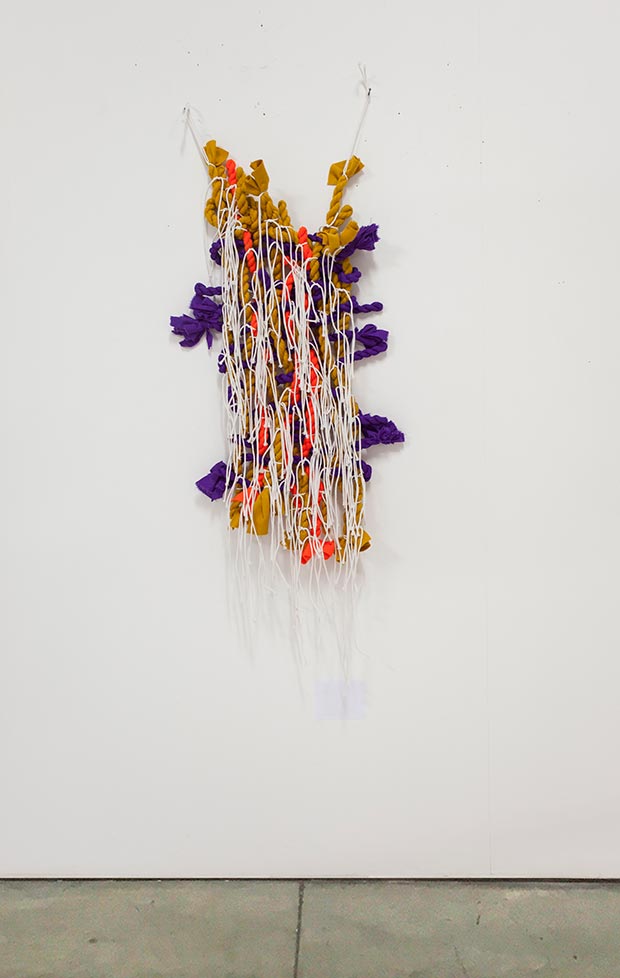 Hassan Sharif, Weaving, 2015, Synthetic fabric, textiles, cotton thread and cotton rope, 152 x 57 x 7 cm / Courtesy of the artist and Gallery Isabelle van den Eynde
Hassan Sharif, Weaving, 2015, Synthetic fabric, textiles, cotton thread and cotton rope, 152 x 57 x 7 cm / Courtesy of the artist and Gallery Isabelle van den Eynde
Hassan Sharif (1951-2016) made a vital contribution to conceptual art and experimental practice in the Middle East through 40 years of performance, installation, drawing, painting and assemblage. Prior to leaving the UAE to study in London in 1979, Sharif gained attention for his cartoons published in the UAE press - ironic, outspoken critiques of the rapid industrialisation of the Emirates and political deadlock of 1970s Arab Nationalism. Sharif’s major retrospective entitled Hassan Sharif: I am the Single Work Artist, curated by Hoor Al Qasimi is on view until 3 February at the Sharjah Art Foundation.
As one of Iran’s most pronounced draughtsman, Amin Nazar draws inspiration from music and poetry to examine the proximity of ephemerality and contradiction. In the four-panel works on paper, particularly stimulated by Syrian writer Sanam Al Ghaman’s poem Dance with Owls, calligraphic script reveals a descending trajectory that is imposed by the force of gravity to challenge the formal style of calligraphic abstraction, while facial features such as eyes, moustache, mouth and hair emerge through the confident interlacing of strokes and lines.
The unconsciousness essentially deals with repetition as witnessed in the singular production of the works of five artists gathered in this exhibition: it is from the repetition of gestures, forms, techniques and materials that the proliferation of these artworks derives from. The artists rely on a deceptively simple visual element – the line – at the heart of their creation through laborious, repetitive and formal attempts. In works by Sharif, Kazem and Divecha, the form emerges from itself and the artists neither resist nor fully command the outcome. In Amin Nazar and Benchamma’s works on paper however, abstraction is pinched with figurative elements, as if the work is a mere research material, allowing the viewer to see beyond than just the surface.
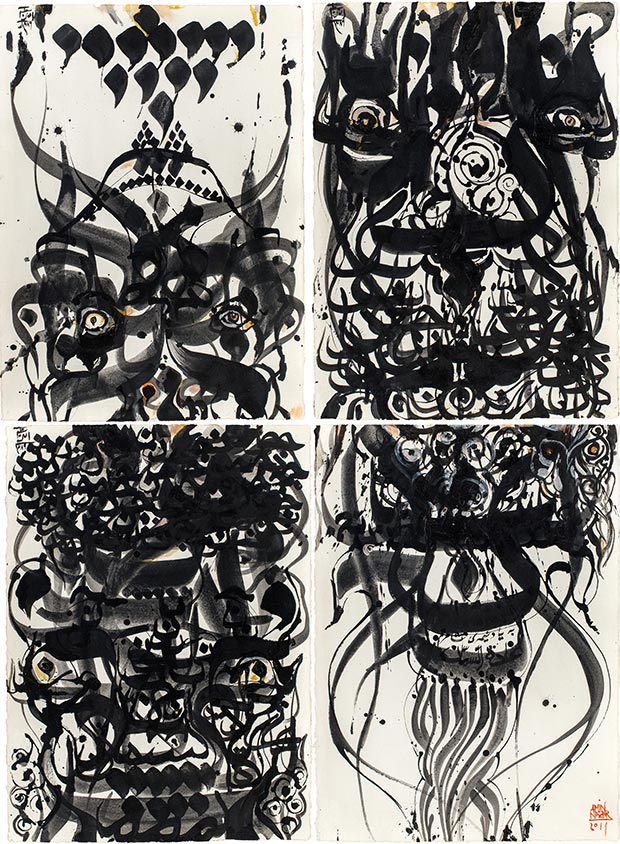 Ahmad Amin Nazar, Untitled, 2011, Set of 4 works, Liquid acrylic on paper, 65.5 x 48 cm each / Courtesy of the artist and Gallery Isabelle van den Eynde
Ahmad Amin Nazar, Untitled, 2011, Set of 4 works, Liquid acrylic on paper, 65.5 x 48 cm each / Courtesy of the artist and Gallery Isabelle van den Eynde
Amin Nazar (born 1955, Iran) studied Fine Art in Tehran. He spent eight years in Cologne where he joined the Society of Painters of Cologne and widely exposed himself to Western art. Upon his return to Iran, he predominantly began working in etching, exploring relationships between miniaturist traditions and Iranian literature, and went on to develop a masterful draughtsmanship. His work manifests the discordance between traditions, both from Iran and the West, as well as modernity. Persian epics, legendary figures, social leaders and macho wrestlers are transformed into disturbed, witty, violent and sensual studies, ink drawings and acrylic masterpieces. A highly anticipated solo exhibition of his works will be presented at Gallery Isabelle van den Eynde in May this year.
In Divecha’s formal study of lines, short intervals of carefully hand drawn lines followed by precisely cut paper articulates the composition to reveal a void that allows us to peak into the mystery within. The artist does not intend to evoke any feelings or emotion, but rather remains anchored in his process. Experimenting and creating parallel lines in this manner highlights Divecha’s approach to chance operations and relinquish the artistic agency to let matter express itself. Keeping the gaps slightly ajar and venturing as closely to its vertiginous edge, the work enables emotions from the unconscious to seep through the conscious self.
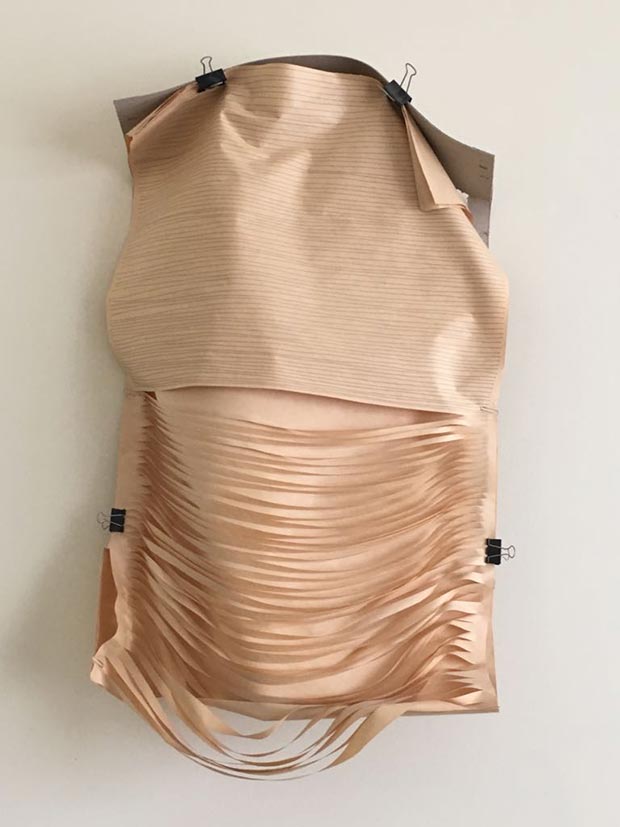 Vikram Divecha, Line Study, 2014, Ink on newsprint paper, cardboard and metal paper clips, Variable dimensions cm / Courtesy of the artist and Gallery Isabelle van den Eynde
Vikram Divecha, Line Study, 2014, Ink on newsprint paper, cardboard and metal paper clips, Variable dimensions cm / Courtesy of the artist and Gallery Isabelle van den Eynde
Vikram Divecha (born 1977, Beirut) is a Mumbai-bred artist based between New York and Dubai. His work addresses labour, time and value, interrogating specific environments and challenging socioeconomic structures. His practice has developed around what he calls ‘found processes’-those forces and capacities at work within state, social, economic and industrial spheres. These processes are his realm of intervention: Divecha introduces ‘glitches’ or realigns a system, which in turn generates an altered, amplified outcome as the operation runs its course. He participates in Co-Lab: Contemporary Art and Savoir-Faire, curated by Alia Zaal Lootah, as part of the Emirati-French cultural programme at the Louvre Abu Dhabi until 25 March.
Comments
Add a comment